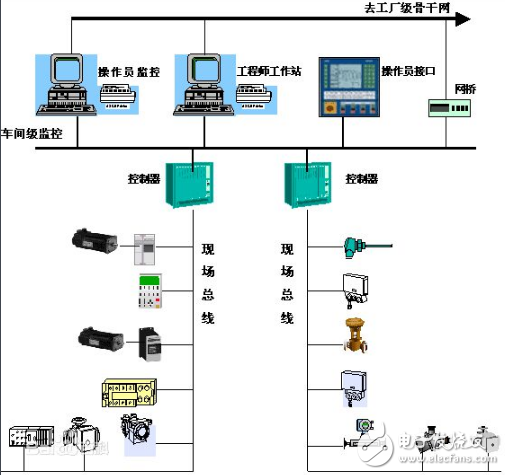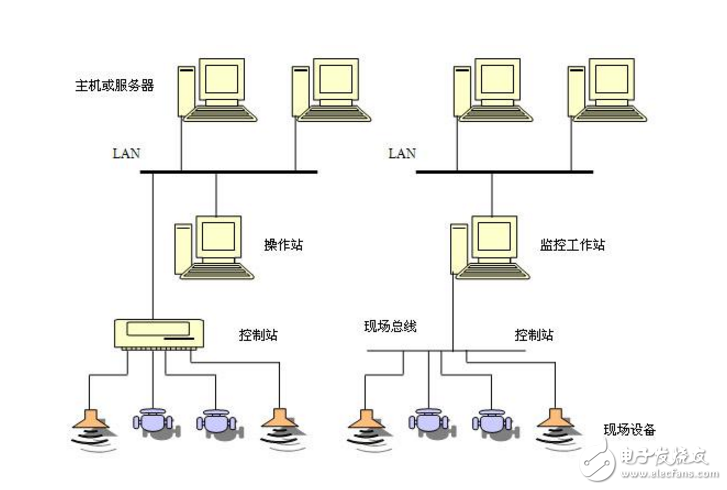Fieldbus refers to a network based on digital communication between measurement and control machines in a factory, also known as a field network. That is, a network that specializes communication between sensors, various operating terminals, and controllers and controllers. Originally, the main wiring between these devices is ON/OFF, contact signal, and analog signal. By digitizing the communication, time division, multiplexing, and multi-pointing are possible, thereby achieving high performance, high reliability, and simple maintenance. Save wiring (sharing sharing).
Fieldbus is an industrial data bus that has been rapidly developed in recent years. It mainly solves the digital communication between field devices such as intelligent instrumentation, controllers and actuators in industrial field, and these field control devices and advanced control. Information transfer issues between systems. Due to the outstanding advantages of fieldbus, such as simple, reliable, economical and practical, it has been highly valued by many standards bodies and computer manufacturers. It is an industrial data bus and is the underlying data communication network in the field of automation.
Simply put, fieldbus replaces the traditional 4-20mA analog signal and ordinary switch signal transmission with digital communication. It is an all-digital, two-way, multi-station communication system that connects intelligent field devices and automation systems.

In 1994, the FF Foundation was formed by the merger of the ISP Foundation and World FIP (North America). The purpose of the FF Foundation was to develop the only international fieldbus (FundaTIon Fieldbus) that complies with IEC and ISO standards. The Low Speed ​​Bus (H1) protocol was published in 1996. The high-speed bus (H2) that has been developed is scheduled to be released in 1998. In May 1997, the China Fieldbus (FF) Professional Committee was established and the FF Fieldbus Product Certification Center was established.
At present, the application field of FF fieldbus is mainly process automation. Such as: chemical, power plant experimental systems, wastewater treatment, oil fields and other industries.
LONWORKS busThe LONWORKS fieldbus is called LONWORKS NetWorks, a distributed intelligent control network technology, and it is hoped to introduce a measurement and control network that can be adapted to various fieldbus applications. LONGWORKS currently has a wide range of applications, including industrial control, building automation, data acquisition, and SCADA systems. Domestically, it is mainly used in building automation.
CANBUS fieldbusThe CANBUS fieldbus has been approved by the ISO/TC22 Technical Committee as the international standard IOS 11898 (communication rate less than 1Mbps) and ISO11519 (communication rate less than 125Kbps). CANBUS's main products are used in automotive manufacturing, public transportation vehicles, robotics, hydraulic systems, and distributed I/O. In addition, it is used in elevators, medical equipment, machine tools, building automation and other occasions.
P-NET fieldbusThe P-NET fieldbus was built in 1983. In 1984, the first products using multi-master fieldbus were introduced. Multiple network structures and multiple interface functions were added to the 1986 communication protocol. In 1987, P-NET's multi-interface products were introduced. In 1987, the P-NET standard became an open and complete standard and became the national standard of Denmark. In 1996 it became part of the European bus standard (EN 50170 V.1). In 1997, the company established an international P-NET user organization with nearly 100 corporate members. It is headquartered in Siekeborg, Denmark, and has regional organization branches in Germany, the United Kingdom, Portugal and Canada.
P-NET fieldbus is widely used in Europe and North America, including petrochemical, energy, transportation, light industry, building materials, environmental engineering and manufacturing applications.
The market competitiveness has been well developed.

INTERBUS is an earlier fieldbus introduced by Phoenix, Germany. In February 2000, it became the international standard IEC61158. INTERBUS adopts the simplified model (1, 2, 7 layers) of the open system interconnection OSI of the International Organization for Standardization ISO, namely the physical layer, the data link layer and the application layer, which has strong reliability, diagnosability and easy maintenance. It adopts lumped frame type data loop communication, which has the characteristics of low speed and high efficiency, and strictly guarantees the synchronization and periodicity of data transmission; the real-time, anti-interference and maintainability of the bus is also excellent. INTERBUS is widely used in the automotive, tobacco, warehousing, paper, packaging, food and other industries, and has become a leader in international fieldbus.
WorldFIP fieldbusThe FIP fieldbus became the national safety standard of France from 90 to 91 years. In 1996, it became the European standard (EN 50170 V.3). The next step is to be close to the IEC standard and is now fully technically prepared. WorldFIP International has an office in Beijing, the WorldFIP China Information Center, which is responsible for China's technical support. WorldFIP fieldbus uses a single bus structure to accommodate different application areas, with different application rates using different bus speeds. The process control is 31.25Kbit/s, the manufacturing is 1M bit/s, and the drive control is 1-2.5Mbit/s. The bus arbiter and priority are used to manage the communication of the various control stations on the bus (including the various branches). Multiple communication methods such as one-to-one, one-to-many (group), and one-to-all can be performed. In the application system, a dual bus structure can be adopted, in which one bus is a backup line, which increases the security of the system operation.
WorldFIP fieldbus is used in a wide range of applications, including process automation, manufacturing automation, power and building automation.
CC-Link fieldbusCC-Link is the abbreviation of Control&CommunicaTIonLink (Control and Communication Link System). In November 1996, it was launched by many companies led by Mitsubishi Electric. Its growth momentum is rapid and it has a large share in Asia. Currently in Europe and North America. develop rapidly. In its system, control and information data can be transmitted to the field network at a high speed of 10 Mbit/s at the same time, which has the advantages of excellent performance, simple use, wide application, and cost saving. It not only solves the complicated problems of industrial field wiring, but also has excellent noise resistance and compatibility. CC-Link is a device-based network that also covers higher-level control layers and lower-level sensing layers. In July 2005, CC-Link was approved by the China National Standards Committee as the guiding technical document for China's national standards.
HART fieldbusHART is an abbreviation of HighwayAddressableRemoteTransduer. Originally developed by Rosemout and supported by more than 80 famous instrument companies, the HART Communication Foundation was established in 1993. This open communication protocol, called the Addressable Remote Sensing High-Speed ​​Channel, is characterized by the realization of digital communication on existing analog signal transmission lines, which is a transitional product of industrial process control in the transition from analog systems to digital systems. The current transition period is strong.
Devicenet fieldbusDevicenet is a low-cost communication bus. It connects industrial equipment (such as limit switches, photoelectric sensors, valve blocks, motor starters, process sensors, bar code readers, variable frequency drives, panel displays and operator interfaces) to the network, eliminating expensive hard wiring cost. Direct interconnectivity improves communication between devices and provides significant device-level diagnostics that are difficult to achieve with hardwired I/O interfaces.
CAN fieldbusCAN is the abbreviation of ControlAreaNetwork, which was first introduced by BOSCH in Germany, and is used for data communication between internal measurement and execution components of automobiles. Its bus specification has been developed into an international standard by the ISO International Standards Organization and has been supported by Motorola, Intel, Philips, Siemens, NEC and other companies. It has been widely used in the field of discrete control. The CAN protocol is also based on the open system interconnection model of the International Standards Organization. However, its model structure has only three layers, and only the physical layer, the data link layer and the top-layer application layer of the OSI underlying layer are taken. The signal transmission medium is twisted pair, the communication speed is up to 1Mbps/40m, the direct transmission distance is up to 10km/kbps, and the maximum number of attachable devices is up to 110.
Profibu fieldbusProfibus is a fieldbus as the German national standard DIN19245 and the European standard prEN50170. The ISO/OSI model is also its reference model. The Profibus series is composed of Profibus-Dp, Profibus-FMS and Profibus-PA. The DP type is used for high-speed transmission between distributed peripherals and is suitable for applications in the field of processing automation. FMS means on-site information specification for general automation such as textiles, building automation, programmable controllers, low-voltage switches, etc., while PA type is a bus type for process automation that complies with the IEC1158-2 standard. The technology was jointly launched by more than a dozen German companies and research institutes led by Siemens. It adopts the physical layer and data link layer of the OSI model. The two parts form a subset of the first part of the standard. The DP type hides the 3-7 layers, and the direct data connection fitting is added as the user interface. The FMS type only hides the third to sixth layers, and uses the application layer as the second part of the standard. The PA type standard is still in the process of development, and its transmission technology complies with IEC1158-2(1) standard, which can realize bus power supply and intrinsically safe explosion-proof.
LonWorks FieldbusLonWorks Fieldbus is a local operating network introduced by Echelon in 1992. It was originally used for building automation, but it soon developed into an industrial field network. LonWorks technology provides a complete, open, and finished solution for designing and implementing interoperable control networks. At the heart of LonWorks technology is the Neuron Chip. The chip is equipped with three microprocessors: the MAC processor completes the medium access control; the network processor completes the OSI layer 3-6 network protocol; the application processor completes the user field control application. Data is passed between them through a common memory. The acquisition and control functions are required in the control unit. For this purpose, the neuron chip is provided with 11 I/O ports. These I/O ports can be flexibly configured with interfaces to peripheral devices according to different requirements, such as RS232, parallel port, timing/counting, interval processing, and bit I/O.
FF fieldbusThe FF Fieldbus Foundation was formed by WORLDFIPNA (North American part, excluding Europe) and ISP FoundaTIon in June 1994. It is an international organization whose goal is to create a single, open, interoperable site. Bus international standard. This organization gave strong support to the IEC Fieldbus Standard Drafting Working Group. The organization currently has more than 100 member units, including the world's leading production companies for process control products and systems. In April 1997, the organization established the China Instrument Association Fieldbus Professional Committee (CFC) in China. Committed to the promotion and application of this technology in China. The establishment of FF was relatively late, and it was later than the introduction of PROFIBUS and WORLDFIP in the launch of its own products and the complete application of this technology to engineering. However, since FF was established in September 1992, it is a combination of two major organizations, ISP (Interoperable Operating System Protocol) and WORLDFIPNA, which are based on FisherRosemount. Therefore, this organization has considerable strength: Currently FF is on IEC fieldbus. The standard formulation process plays a pivotal role.
Lcd Bar Display,Shelf Edge Display,Stretched Bar Lcd,Stretched Bar Display
APIO ELECTRONIC CO.,LTD , https://www.displayapio.com
